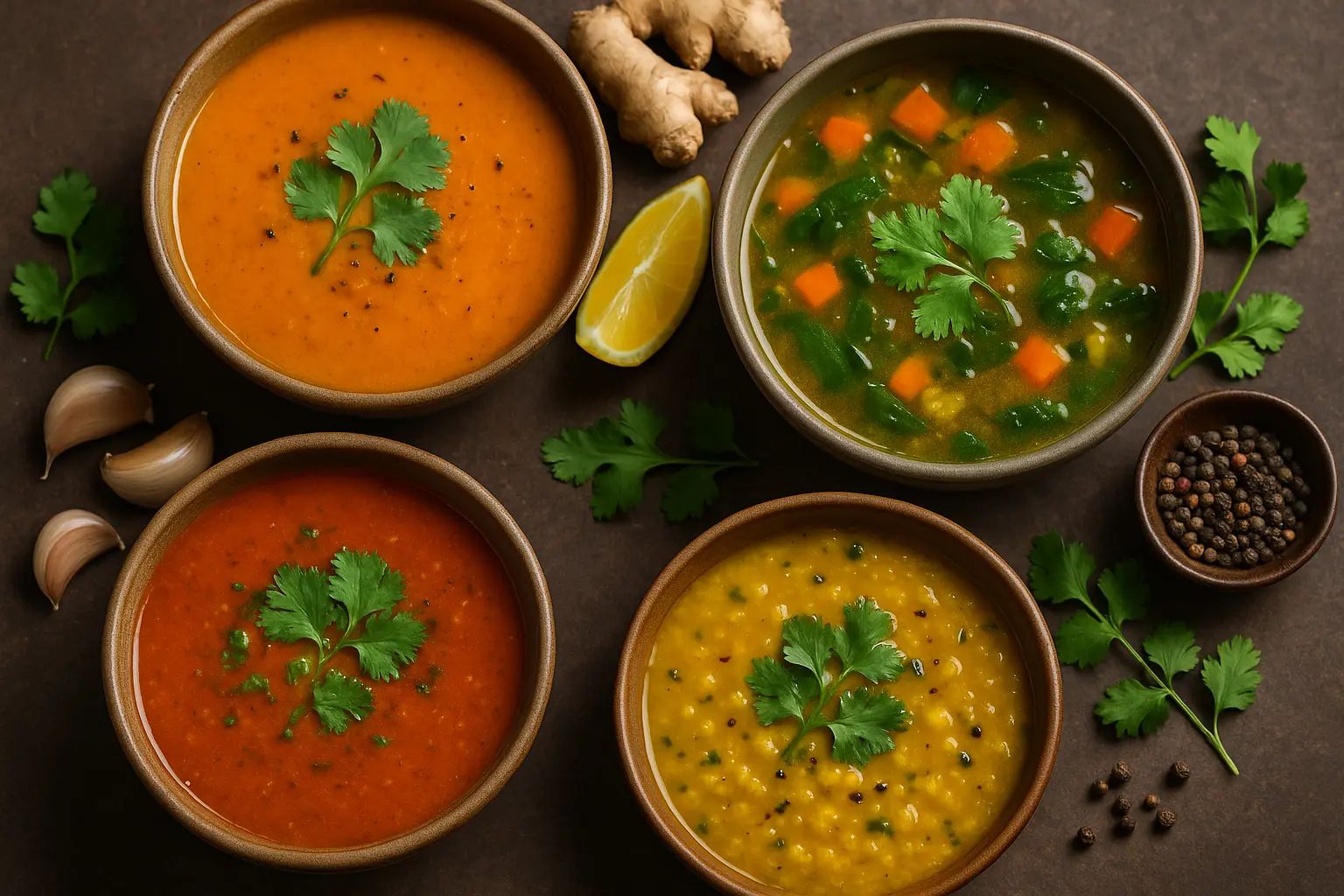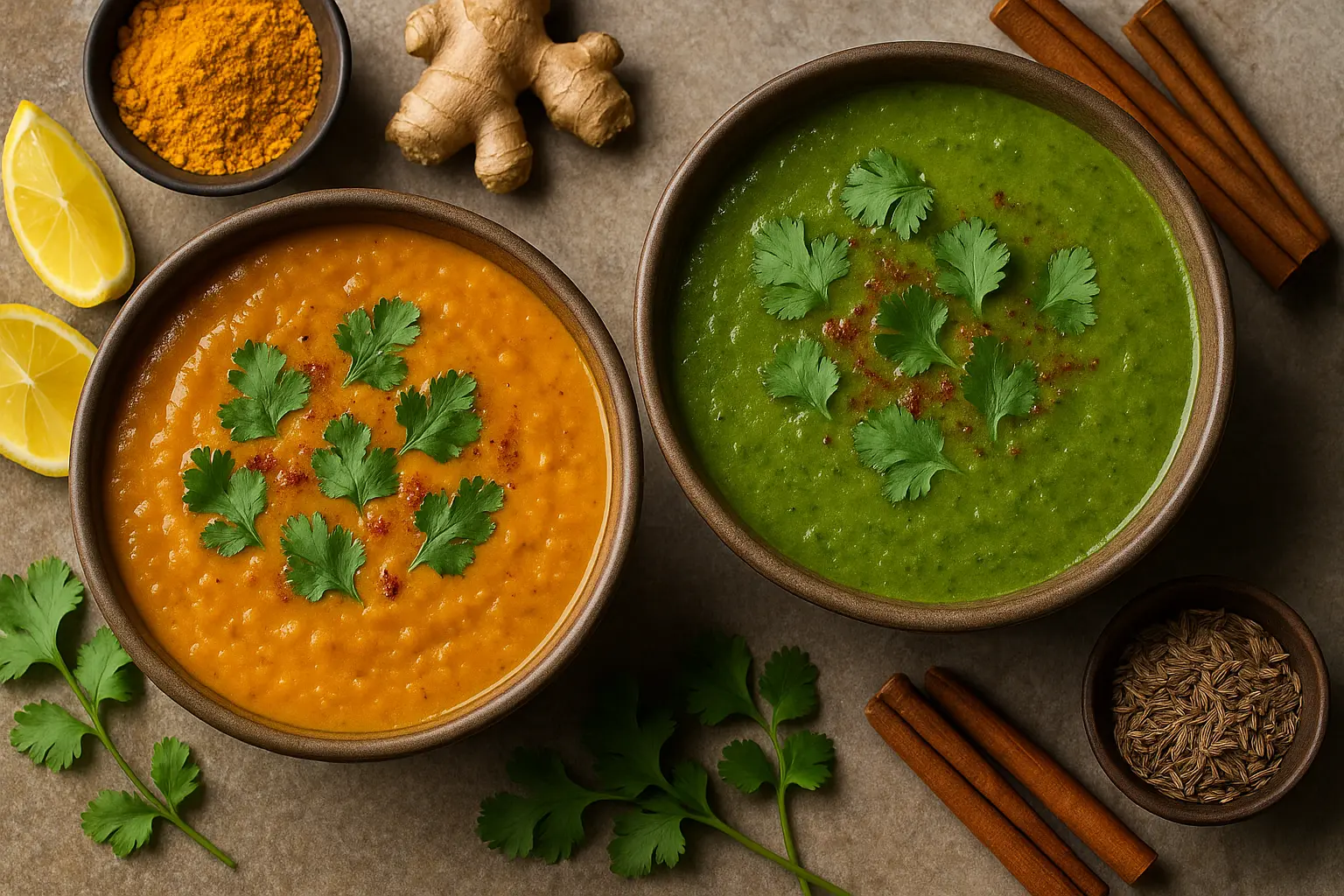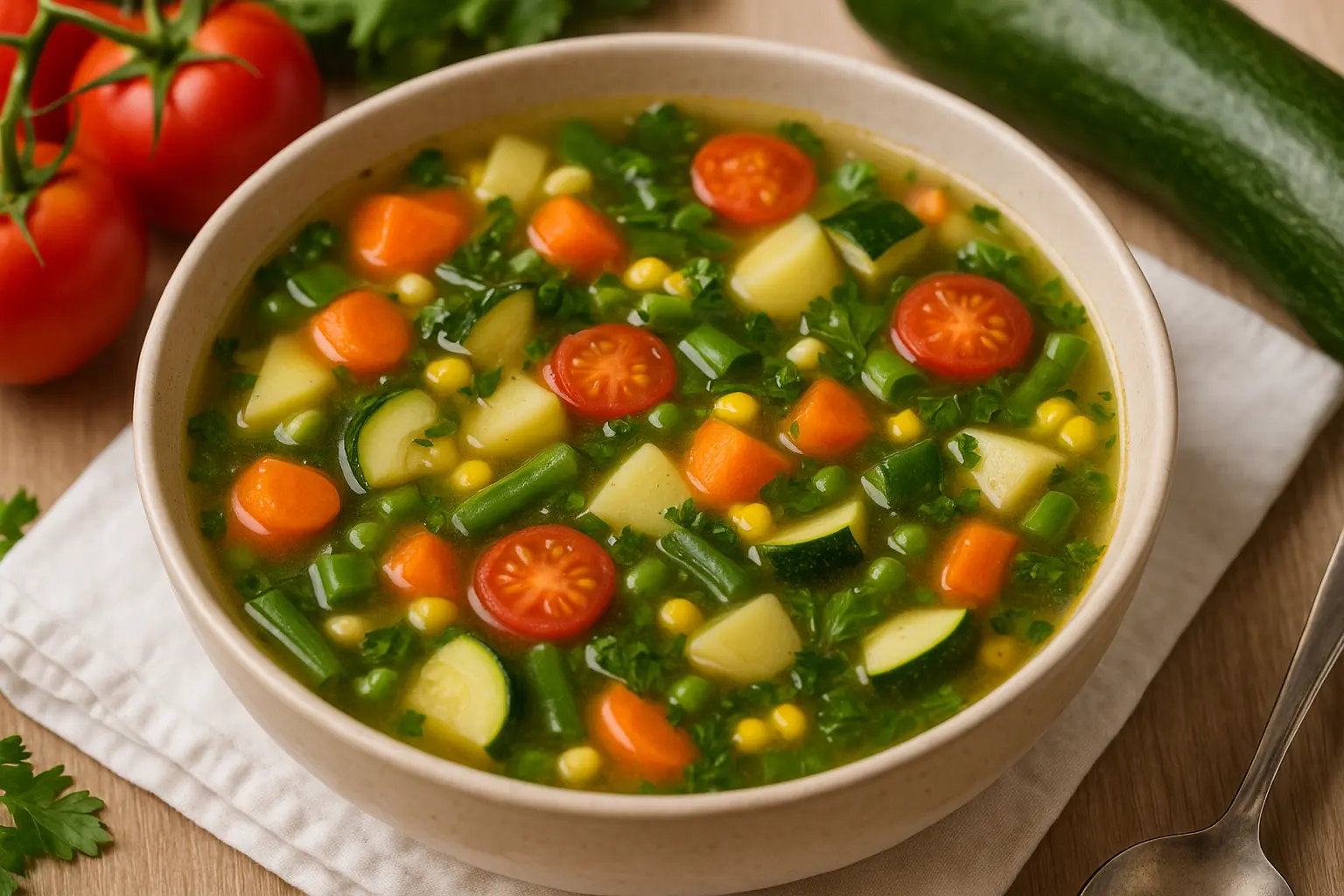When the flu season rolls in, there’s nothing quite as comforting as a steaming bowl of soup. In Indian households, soups aren’t just about warmth and flavor—they’re often crafted with medicinal spices and herbs that have been trusted for centuries. Ingredients like turmeric, ginger, garlic, black pepper, and cumin don’t just add depth of flavor, but also provide proven immune-boosting and anti-inflammatory properties.
This long-form guide brings together a collection of Indian-spiced soups designed for flu season. We’ll explore traditional recipes, modern twists, Ayurvedic wisdom, nutritional benefits, and practical cooking tips so you can enjoy healing soups at home.

Why Indian Spices Are Perfect for Flu Season
The Science of Spices
Turmeric: Contains curcumin, a powerful anti-inflammatory compound that helps fight infections.
Ginger: Known to ease sore throats, improve digestion, and reduce nausea.
Garlic: Packed with allicin, which supports the immune system and has antimicrobial effects.
Black Pepper: Enhances the absorption of curcumin from turmeric and clears nasal congestion.
Cumin & Coriander: Aid digestion and provide warmth to the body.
Ajwain (Carom Seeds): Traditional remedy for coughs and colds, often infused into broths.
The Comfort Factor
Soups provide hydration, which is crucial when battling the flu. Warm broths help soothe a sore throat, while the steam clears sinuses. Combined with the healing powers of Indian spices, these soups serve as natural medicine in a bowl.
Classic Indian-Spiced Soup Recipes
1. Turmeric & Ginger Rasam (South Indian Healing Soup)
Rasam is a tangy, peppery broth made with tamarind, black pepper, garlic, and curry leaves. A version tailored for flu season includes extra turmeric and ginger for immune support.
Ingredients:
Tamarind pulp (or lemon juice for a lighter option)
Turmeric powder
Fresh ginger (grated)
Garlic cloves
Black pepper & cumin (coarsely ground)
Curry leaves
Mustard seeds
Coriander leaves
Why it Works: The heat from pepper clears nasal passages, turmeric reduces inflammation, and tamarind adds Vitamin C.
2. Moong Dal Soup with Garlic Tadka
Light, protein-rich, and easy to digest, moong dal soup is perfect for when your appetite is low.
Ingredients:
Split yellow moong dal
Turmeric & ginger
Garlic tempered in ghee or oil
Cumin seeds
Fresh coriander
Why it Works: Gentle on the stomach yet nourishing, this soup is Ayurvedic-approved for flu recovery.
3. Spiced Tomato Shorba
Shorba is India’s answer to soup, often thinner than Western soups but bursting with flavor.
Ingredients:
Fresh ripe tomatoes
Ginger & garlic paste
Cinnamon, cloves, and bay leaf
Black pepper and cumin
Fresh coriander
Why it Works: Rich in antioxidants (lycopene), this soup fights free radicals while keeping you warm.
4. Ayurvedic Vegetable Broth with Ajwain & Tulsi
This simple broth uses healing spices and herbs to soothe cough and sore throat.
Ingredients:
Carrot, zucchini, spinach (seasonal veg)
Ajwain seeds
Tulsi (holy basil) leaves
Turmeric & black pepper
Rock salt (saindhav namak)
Why it Works: Ajwain and tulsi are time-tested remedies in Indian households, aiding in clearing phlegm and boosting lung health.
5. Khichdi-Inspired Soup
Khichdi is a comfort dish made with rice and lentils, but here it’s thinned into a soup consistency for flu relief.
Ingredients:
Rice and yellow moong dal
Turmeric & cumin
Ginger paste
A dollop of ghee (optional)
Why it Works: Provides protein, carbs, and healing spices in one soothing bowl.
Fusion & Modern Twists
Coconut Milk Turmeric Soup: Creamy yet dairy-free, enriched with curry spices.
Carrot-Ginger-Cumin Soup: Sweet carrots balanced by warming spices.
Spinach & Garlic Lentil Soup: Iron-rich, perfect when you’re feeling weak.
Quinoa & Masoor Dal Soup: A protein-packed modern take.
Ayurvedic Principles for Healing Soups
According to Ayurveda, illness often stems from imbalances in the body. Flu is associated with Kapha dosha aggravation, leading to congestion, sluggish digestion, and fatigue.
Guidelines:
Use warming spices (ginger, pepper, cinnamon).
Avoid heavy creams; choose light broths.
Drink soups warm, never cold.
Add herbs like tulsi, coriander, and mint for balance.
Nutrition Benefits
| Ingredient | Key Nutrient | Benefit in Flu Season |
|---|---|---|
| Turmeric | Curcumin | Anti-inflammatory, boosts immunity |
| Ginger | Gingerol | Reduces sore throat, aids digestion |
| Garlic | Allicin | Antibacterial, antiviral |
| Lentils | Protein & Iron | Energy and repair |
| Tomatoes | Lycopene, Vit C | Antioxidant, boosts recovery |
| Tulsi | Phytochemicals | Respiratory support |
Practical Cooking Tips
Roast spices before adding for deeper flavor.
Always temper (tadka) garlic, cumin, or mustard seeds in oil/ghee to release aroma.
Use pressure cooker or Instant Pot for quick cooking.
Store broth in glass jars for up to 3 days, reheat before drinking.
Add a squeeze of lemon before serving for Vitamin C boost.
Suggested Weekly Soup Plan for Flu Season
Day 1: Ginger-Turmeric Rasam
Day 2: Moong Dal Garlic Soup
Day 3: Tomato Shorba
Day 4: Spinach & Garlic Lentil Soup
Day 5: Coconut Milk Turmeric Soup
Day 6: Khichdi-Inspired Soup
Day 7: Vegetable Broth with Tulsi
This way, you cover a variety of flavors while consistently nourishing your body.
Comfort Beyond the Flu
These soups are not only for when you’re sick. They work as:
Prevention meals: Build immunity before flu season hits.
Detox soups: Light and easy after heavy meals.
Comfort food: Ideal for winter evenings.
Kid-friendly immunity boosters: Mildly spiced versions are great for children.
Conclusion
Indian-spiced soups are more than just recipes—they are a blend of tradition, nutrition, and healing. With spices that double as natural medicine, these soups offer both comfort and wellness during flu season. Whether you prefer a light rasam, a hearty dal-based soup, or a modern coconut milk twist, there’s an Indian-inspired bowl for everyone.
So next time the flu strikes—or even when you just crave something warm and soothing—let these soups be your go-to remedy.
Leave a comment
Your email address will not be published. Required fields are marked *




















